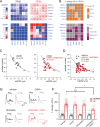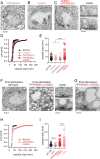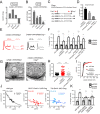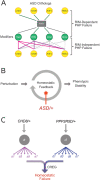Homeostatic plasticity fails at the intersection of autism-gene mutations and a novel class of common genetic modifiers
- PMID: 32609087
- PMCID: PMC7394548
- DOI: 10.7554/eLife.55775
Homeostatic plasticity fails at the intersection of autism-gene mutations and a novel class of common genetic modifiers
Abstract
We identify a set of common phenotypic modifiers that interact with five independent autism gene orthologs (RIMS1, CHD8, CHD2, WDFY3, ASH1L) causing a common failure of presynaptic homeostatic plasticity (PHP) in Drosophila. Heterozygous null mutations in each autism gene are demonstrated to have normal baseline neurotransmission and PHP. However, PHP is sensitized and rendered prone to failure. A subsequent electrophysiology-based genetic screen identifies the first known heterozygous mutations that commonly genetically interact with multiple ASD gene orthologs, causing PHP to fail. Two phenotypic modifiers identified in the screen, PDPK1 and PPP2R5D, are characterized. Finally, transcriptomic, ultrastructural and electrophysiological analyses define one mechanism by which PHP fails; an unexpected, maladaptive up-regulation of CREG, a conserved, neuronally expressed, stress response gene and a novel repressor of PHP. Thus, we define a novel genetic landscape by which diverse, unrelated autism risk genes may converge to commonly affect the robustness of synaptic transmission.
Keywords: CHD8; CREG; D. melanogaster; autism; homeostatic plasticity; neuroscience; neurotransmission; presynaptic.
© 2020, Genç et al.
Conflict of interest statement
ÖG, JA, RF, YK, GZ, SS No competing interests declared, GD Reviewing editor, eLife
Figures



















Similar articles
-
α2δ-3 Is Required for Rapid Transsynaptic Homeostatic Signaling.Cell Rep. 2016 Sep 13;16(11):2875-2888. doi: 10.1016/j.celrep.2016.08.030. Cell Rep. 2016. PMID: 27626659 Free PMC article.
-
MCTP is an ER-resident calcium sensor that stabilizes synaptic transmission and homeostatic plasticity.Elife. 2017 May 9;6:e22904. doi: 10.7554/eLife.22904. Elife. 2017. PMID: 28485711 Free PMC article.
-
The E3 ligase Thin controls homeostatic plasticity through neurotransmitter release repression.Elife. 2022 Jul 7;11:e71437. doi: 10.7554/eLife.71437. Elife. 2022. PMID: 35796533 Free PMC article.
-
Animal models of autism spectrum disorder (ASD): a synaptic-level approach to autistic-like behavior in mice.Exp Anim. 2013;62(2):71-8. doi: 10.1538/expanim.62.71. Exp Anim. 2013. PMID: 23615300 Review.
-
The genetics of autism.Pediatrics. 2004 May;113(5):e472-86. doi: 10.1542/peds.113.5.e472. Pediatrics. 2004. PMID: 15121991 Review.
Cited by
-
Regulation of presynaptic homeostatic plasticity by glial signalling in Alzheimer's disease.J Physiol. 2024 Dec 20:10.1113/JP286751. doi: 10.1113/JP286751. Online ahead of print. J Physiol. 2024. PMID: 39705214 Review.
-
Genomics, convergent neuroscience and progress in understanding autism spectrum disorder.Nat Rev Neurosci. 2022 Jun;23(6):323-341. doi: 10.1038/s41583-022-00576-7. Epub 2022 Apr 19. Nat Rev Neurosci. 2022. PMID: 35440779 Free PMC article. Review.
-
The CHD family chromatin remodeling enzyme, Kismet, promotes both clathrin-mediated and activity-dependent bulk endocytosis.PLoS One. 2024 Mar 21;19(3):e0300255. doi: 10.1371/journal.pone.0300255. eCollection 2024. PLoS One. 2024. PMID: 38512854 Free PMC article.
-
Investigating autism associated genes in C. elegans reveals candidates with a role in social behaviour.PLoS One. 2021 May 27;16(5):e0243121. doi: 10.1371/journal.pone.0243121. eCollection 2021. PLoS One. 2021. PMID: 34043629 Free PMC article.
-
Distinct molecular pathways govern presynaptic homeostatic plasticity.Cell Rep. 2021 Dec 14;37(11):110105. doi: 10.1016/j.celrep.2021.110105. Cell Rep. 2021. PMID: 34910905 Free PMC article.
References
-
- Baetz KK, Krogan NJ, Emili A, Greenblatt J, Hieter P. The ctf13-30/CTF13 genomic haploinsufficiency modifier screen identifies the yeast chromatin remodeling complex RSC, which is required for the establishment of sister chromatid cohesion. Molecular and Cellular Biology. 2004;24:1232–1244. doi: 10.1128/MCB.24.3.1232-1244.2003. - DOI - PMC - PubMed
Publication types
MeSH terms
Substances
Associated data
- Actions
Grants and funding
LinkOut - more resources
Full Text Sources
Molecular Biology Databases
Miscellaneous

